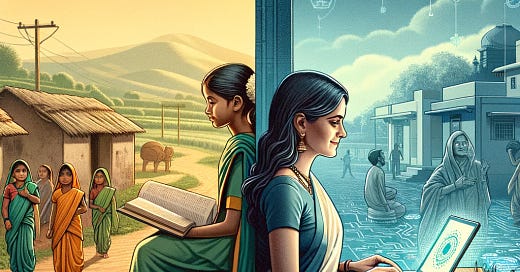Building Bridges, Building Futures
Bridging the Gender Gap: Education, Digital Access, and India's Path to Development
- Vikram Gopinath & Harpreet Kaur
India's economic and social progress relies on harnessing the full potential of its population, including the critical contribution of women. Yet, the nation faces a stark reality: a female labour force participation rate (FLPR) of only 28%, compared to a global average of 53% and a staggering 76% for men in India itself. This disparity impedes individual opportunities and poses a significant obstacle to achieving India's ambitious goal of becoming a developed nation by 2047.
Education: The Foundation for Empowerment
Education plays a key role in bridging the gender gap and empowering women to participate actively in the workforce. However, assessments like the recent Annual Status of Education Report (ASER) 2023 paint a concerning picture. The report reveals a dire state of foundational skills in rural India, particularly among the age group of 14-18 years, where a significant portion struggles with basic reading comprehension and arithmetic.
A quarter of the surveyed students could not read basic text fluently in their regional language, more than a third couldn't speak English and more than a half struggled with division problems; a skill expected to be attained in Standard III/IV.
This highlights the need for immediate and targeted interventions to strengthen foundational skills, particularly for girls, who often face additional challenges due to socioeconomic factors and deep-rooted gender norms.
While ASER reports a positive trend in female enrollment in colleges, the mere pursuit of higher education doesn't guarantee career readiness. The report suggests a disconnect between educational attainment and the specific knowledge and skills required for successful workforce participation. Aligning education with industry needs and promoting vocational training, as emphasized in the National Education Policy 2020, are crucial steps towards ensuring that women acquire the skills necessary to thrive in the modern economy.
Digital Literacy: A Potential Bridge?
The report also points to a potential equalizer: rising digital literacy among both genders. With mobile phone penetration exceeding 70%, youth increasingly utilise smartphones for diverse purposes, including education. Youth who owned a mobile phone in the surveyed age group had an aptitude for simple digital tasks like browsing YouTube and Google, using Google Maps and awareness of using the phone for entertainment and education-related videos. However, mere access to educational content is insufficient. Self-motivation and engaging interactive learning resources generated by AI are crucial for effective knowledge acquisition and skill development.
The gender gap in smartphone ownership, with males twice as likely to own a phone compared to females, presents another challenge. This disparity limits access to digital opportunities and learning resources, further exacerbating the gender gap in skill development. Bridging this digital divide through targeted initiatives and affordable data plans is essential to ensure equitable access to the empowering potential of technology.
Beyond Access: Building a Supportive Ecosystem
While digital access offers a promising avenue, it must be integrated into a broader ecosystem that addresses the root causes of the gender gap. This includes dismantling traditional gender roles that limit girls' educational opportunities and career aspirations. The examples in the survey also highlight the importance of role models at home and school, often teachers and parents. Additionally, providing mentorship, career guidance, exposure and access to role models can empower young women to navigate the path from education to employment.
Conclusion: A Call to Action
Bridging the gender gap in India requires a multi-pronged approach that addresses both educational challenges and the limitations of traditional mindsets. Investing in foundational skills, aligning education with industry needs, and promoting vocational training are crucial first steps. Leveraging the potential of digital literacy while addressing the digital divide is equally important. Ultimately, a supportive ecosystem that empowers young women with the knowledge, skills, and confidence to pursue their aspirations is essential for India to unlock its true potential and achieve its vision of a developed nation.
References
https://data.worldbank.org/indicator/SL.TLF.CACT.MA.NE.ZS?locations=IN
https://asercentre.org/wp-content/uploads/2022/12/ASER-2023-Report-1.pdf
https://asercentre.org/wp-content/uploads/2022/12/ASER-2023-Report-1.pdf




